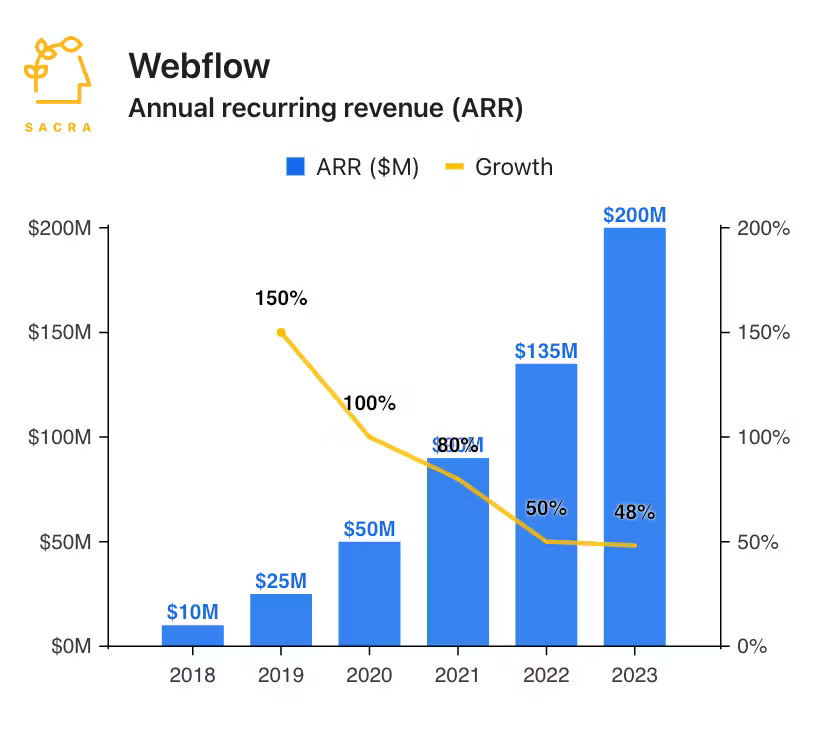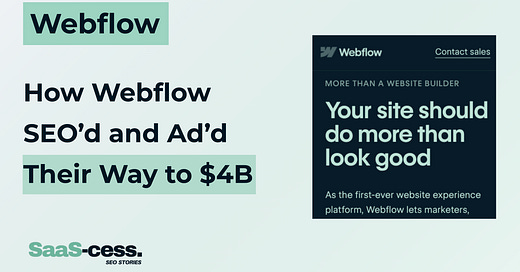Growth hackers lied to you.
The playbook said spend more, scale faster, burn cash like it’s oxygen.
But Webflow’s team ignored all that, and turned $100k into $100M+ ARR.
“We had to build this growth engine very profitably. This was not growth at all costs.” – Tim D., Director of Growth
No hype. No bullshit. Just a $4B empire built on constraints.
Here’s the playbook they tried to hide.
Act 1: The Attribution Wars
Every ad platform is lying to you.
Not maliciously—just... systematically.
Run a Meta campaign? It’ll steal credit from organic search.
Bid on Google Ads? It’ll attribute sales that started on YouTube.
Most marketers optimise towards these fake metrics... until their scaling efforts mysteriously bleed out.
Webflow refused to play that game.
Their weapon:
Custom attribution engine that tracked every touchpoint
Isolated "brand" spend (defensive) from performance spend (offensive)
Geo-lift experiments - killing ads in entire regions to measure true impact
"When we reported CAC, we included performance brand budgets but not the conversions. That’s the right way, it’s a necessary tax." - Tim
In other words… no sandbagged metrics, no dopamine dashboards. Just cold, honest numbers—however uncomfortable.
Act 2: The Youtube Heist
Most companies live and die by Meta.
Webflow did too, until Apple’s ATT update torched their tracking.
Instead of panicking, they pulled off one of the most underrated pivots in growth history: they went all-in on YouTube.
But not just any YouTube ads:- Custom Intent Targeting.
Here’s how it worked:
You search"best website builder" on Google.
Next thing you know, Webflow’s ad pops up the moment you open YouTube.
"We found a channel that was 50% lower CAC than Meta. So I transitioned almost everything over in 3 months." - Tim D
Why it worked:
Same intent as Google Search ads (but cheaper)
Fewer competitors bidding
Native ad formats (no annoying banners, just video).
(This is still live today, btw. And most marketers STILL don’t know about it.)
Act 3: SEO as a Trust Engine
SEO wasn't just traffic.
For Webflow, it was a trust engine. A way to show, not tell. To win the click and the confidence.
UGC as Social Proof
Let users build sites on Webflow, then showcase them in their Marketplace.
Thousands of real examples = instant credibility.
Programmatic Authority
Dynamically created pages for untapped searches (e.g., "portfolio website examples").
High-intent keywords, minimal effort.
Product-Led Linking
Every site built on Webflow linked back to them.
"At Webflow, we had decent domain authority. Many sites were hosted on our subdomains, so there were a lot of links back." - Tim D
Turns out, the best SEO strategy?
Make something useful, then get out of the way.
The Payoff: 100M+ ARR ,4B Valuation
By the time Tim left in 2022, Webflow’s growth engine ran itself.

35% of net new revenue came from growth marketing.
YouTube and SEO quietly drove the biggest returns.
A lean team, multiplying impact.
But the real lesson here wasn’t the tactics, it was the mindset
Constraints created focus. Their $100K budget became an edge.
Attribution was truth. Ad platforms don’t get to grade themselves.
Channels evolve, systems don’t. They built adaptability into their DNA.
The TL;DR for Busy SaaS Teams
In 2016, with just $100K for the entire year, Webflow built a growth engine that scaled to $100M+ ARR and a $4B valuation by 2022. How?
Called BS on ad platforms
Built their own attribution to track real conversionsSplit "brand tax" from performance spend
No fuzzy math allowedDitched Meta after ATT torched tracking
Discovered YouTube's hidden gem:
→ Custom intent targeting (50% cheaper CAC)Turned users into SEO engines
Via backlinks + UGC
Source & Next Steps
All insights come straight from Tim D. (Webflow’s former Director of Growth), via:🎙️ Ahrefs Podcast – Episode with Tim Soulo
Want More?
🔍 Got a SaaS you want me to tear down next? Hit reply.
📚 Or browse past breakdowns here







